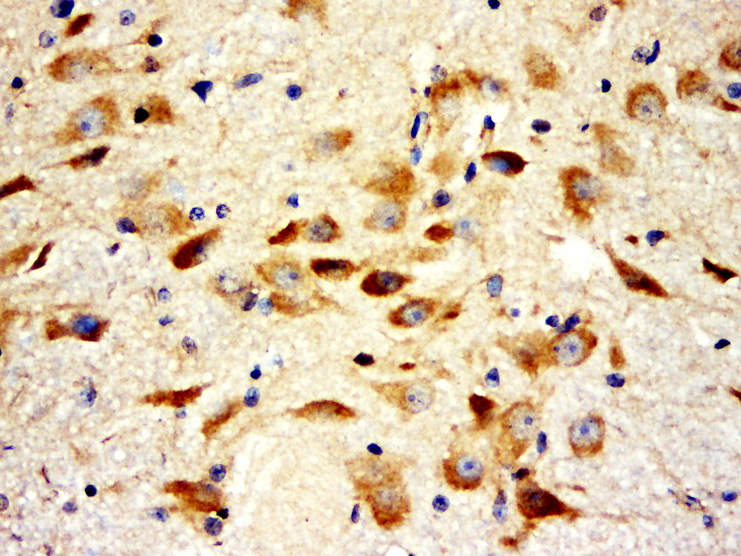
Rabbit Anti-Rap2A antibody
KREV; RAP2A, member of RAS oncogene family; Ras-related protein Rap-2a; RbBP 30; RbBP30; RAP2A_HUMAN.
View History [Clear]
Details
Product Name Rap2A Chinese Name Rap2A抗体 Alias KREV; RAP2A, member of RAS oncogene family; Ras-related protein Rap-2a; RbBP 30; RbBP30; RAP2A_HUMAN. Research Area Cell biology immunology Immunogen Species Rabbit Clonality Polyclonal React Species Rat, (predicted: Human, Mouse, Chicken, Dog, Cow, Horse, Rabbit, Sheep, ) Applications WB=1:500-2000 ELISA=1:5000-10000 IHC-P=1:100-500 IHC-F=1:100-500 IF=1:50-200 (Paraffin sections need antigen repair)
not yet tested in other applications.
optimal dilutions/concentrations should be determined by the end user.Theoretical molecular weight 21kDa Cellular localization cytoplasmic The cell membrane Form Liquid Concentration 1mg/ml immunogen KLH conjugated synthetic peptide derived from human Rap2A: 121-183/183 Lsotype IgG Purification affinity purified by Protein A Buffer Solution 0.01M TBS(pH7.4) with 1% BSA, 0.03% Proclin300 and 50% Glycerol. Storage Shipped at 4℃. Store at -20 °C for one year. Avoid repeated freeze/thaw cycles. Attention This product as supplied is intended for research use only, not for use in human, therapeutic or diagnostic applications. PubMed PubMed Product Detail Ras oncogenes encode GTP-binding proteins that are capable of transforming immortalized cells in culture. Two Ras-related human genes, designated RAP1A and RAP1B, encode 95% homologous proteins (namely Rap 1A and Rap 1B) that share a similar C-terminal Cys-Ali-Ali-Xaa sequence with Ras proteins and are ubiquitously expressed in mammalian tissues. The putative “effector” domain of Ras proteins, whose integrity is required for cell transformation as well as interaction with the putative effector protein GAP, is conserved in both Rap 1 proteins. Rap 1A is thought to interfere with Ras effector function by binding to Ras GAP in a GTP-dependent manner without affecting Rap 1A GTPase activity. Rap 2, another Ras-related protein, shares 60% identity with Rap 1A and exhibits a carboxy terminal CAAX motif and two upstream cysteines similar to those of the H-Ras, K-Ras and N-Ras proteins. In contrast with Rap 1A and Rap 1B, overexpression of Rap 2 does not interfere with the Ras signaling pathway.
Function:
Small GTP-binding protein which cycles between a GDP-bound inactive and a GTP-bound active form. In its active form interacts with and regulates several effectors including MAP4K4, MINK1 and TNIK. Part of a signaling complex composed of NEDD4, RAP2A and TNIK which regulates neuronal dendrite extension and arborization during development. More generally, it is part of several signaling cascades and may regulate cytoskeletal rearrangements, cell migration, cell adhesion and cell spreading.
Subunit:
Interacts (GTP-bound form) with RUNDC3A. Interacts with RGS14; the interaction is GTP-dependent (By similarity). Interacts with PLCE1. Interacts with ARHGAP29, SGSM1, SGSM2 and SGSM3. Interacts (GTP-bound form preferentially) with TNIK (via the CNH domain); the interaction is direct and recruits RAP2A to the E3 ubiquitin ligase NEDD4. Interacts with MINK1. Interacts (GTP-bound form preferentially) with MAP4K4. Interacts with cytoskeletal actin.
Subcellular Location:
Recycling endosome membrane; Lipid-anchor; Cytoplasmic side. Note=May also localize to the Golgi (PubMed:7962206) and the gelatinase-containing granules of neutrophils (PubMed:8391995).
Post-translational modifications:
Ubiquitinated; undergoes 'Lys-63' monoubiquitination and diubiquitination by NEDD4. Multiple lysine residues are probably modified. Ubiquitination requires TNIK, prevents interaction with effectors and inactivates RAP2A.
Palmitoylated. Palmitoylation is required for association with recycling endosome membranes and activation of TNIK (By similarity).
Similarity:
Belongs to the small GTPase superfamily. Ras family.
SWISS:
P10114
Gene ID:
5911
Database links:Entrez Gene: 5911 Human
Omim: 179540 Human
SwissProt: P10114 Human
Product Picture
References (0)
No References
Bought notes(bought amounts latest0)
No one bought this product
User Comment(Total0User Comment Num)
- No comment



 +86 571 56623320
+86 571 56623320
 +86 18668110335
+86 18668110335

